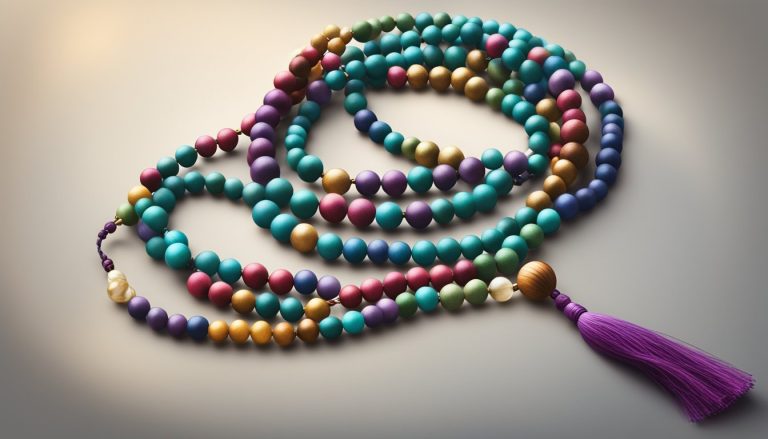Mala Bead Counting Techniques: Master Your Meditation Practice
Mala beads have been used for centuries as a tool for meditation and prayer. Traditionally, a mala, which means “garland” in Sanskrit, consists of 108 beads and is used for keeping count during mantra meditations.
As I recite a mantra silently or aloud, I pass a bead through my fingers for each repetition.
This practice allows me to keep track of the number of times I’ve repeated the mantra without breaking focus to count mentally.

As someone passionate about incorporating mala beads into my spiritual routine, I appreciate the tactile experience they provide.
The process of passing each bead through my fingers becomes a rhythm that helps deepen my meditation, allowing a more profound sense of awareness and tranquility.
There are various techniques for counting mala beads, and although the method may differ from one person to another, the goal remains the same – to aid in a focused, intentional meditation practice.
Key Points
- Mala beads support meditation by helping track mantra repetitions.
- The standard mala contains 108 beads for traditional practices.
- Techniques in using mala beads can vary and enhance personal spiritual routines.
Table of Contents
Origin and Significance
Mala beads hold a rich tapestry of history and spirituality within their simple strings of knots and beads. They’ve moved through ages and cultures, evolving but always retaining their profound purpose.
Cultural Background
I’ve discovered that mala beads have their roots deeply embedded in the practices of Hinduism and Buddhism.
It’s believed that the tradition of using mala beads begins in ancient India.
In Sanskrit, “mala” translates to “garland,” and these beads are used in a meditation practice known as “japa,” which means to recite. In Hinduism, malas are often strung with 108 beads, a number of great significance, reflecting the universe’s interconnected nature.
Tonally, a mala bead for counting in meditation also carries symbolic meaning. Additionally, there is often a 109th bead, known as the “guru bead,” which serves as a starting and ending point for recitation and reflection.
Symbolism in Bead Numbers
When I delve into the symbolism of the bead numbers themselves, it’s fascinating to note that each bead in a mala is meant for a specific mantra recitation, prayer, or intention.
For example, the number 108 is sacred in many Eastern traditions, encompassing the wholeness of existence. This number is also significant in mathematics, astronomy, and other religious systems, indicating a universal connection to the spiritual practice.
- Hinduism: The number 108 is said to represent the universe as one thing (1), nothing (0), and everything (8, or infinity).
- Buddhism: Many practitioners use malas of fewer beads, such as 21 or 28, for shorter meditations that revolve around different cycles and paths to enlightenment.
In my exploration, I’ve learned the intricate ties each bead carries to not just individual well-being but to the cosmos at large.
Choosing Your Mala

When I look for a mala, it’s vital to consider not only the aesthetics but also the materials used and what they symbolize, as well as the personal intentions I plan to set.
Materials and Meanings
Choosing the right material for my mala beads is a deeply personal decision, with each material carrying its own energy and significance. Here’s a brief overview:
- Stone: Stones like quartz or amethyst can enhance specific energies. For example, rose quartz is known for promoting love and compassion.
- Wood: Wooden malas, often made from sandalwood or bodhi seeds, carry a natural, grounding energy and a subtle, soothing fragrance.
- Seeds: Seeds, such as rudraksha, are revered for their spiritual significance and are believed to carry shakti (power).
- Crystal: Crystals are chosen for their clarity and are thought to amplify intentions and energies.
Selecting Based on Intention
My intention plays a pivotal role in selecting a mala. Each stone or seed holds unique properties that can align with my personal goals or spiritual pursuits. For example:
- For clarity and focus: I might choose clear quartz.
- To foster love and healing: Rose quartz would be my go-to.
- Seeking grounding and protection: Black tourmaline is a strong contender.
It’s all about what resonates with me and what I feel drawn to, whether for meditation, reflection, or as a touchstone throughout my day. My personal choice ultimately defines the mala that’s right for me.
Mala Bead Counting Techniques
In my practice, I’ve discovered that the techniques for counting Mala beads can enhance the focus and deepen the meditation experience. Let’s explore the methods that intertwine counting beads with mantra recitation and breath control.
Basic Counting Method
When I begin my meditation practice, I like to use the Basic Counting Method.
This is a simple approach where I hold my Mala in one hand and use my thumb to pull one bead towards me for each chant of my mantra.
I usually start at the guru bead, which is the larger bead, and move around the Mala until I have completed a full circle of 108 beads, signifying one full cycle of mantra recitation. This method keeps me grounded and helps maintain my concentration.
- Start at the guru bead.
- Use your thumb to count each bead.
- Recite your mantra once per bead.
- Complete the cycle of 108 beads.
Advanced Techniques
As I progressed, I wanted to delve deeper, so I learned some Advanced Techniques.
I incorporate my breath into the counting, synchronizing my breath with each bead and mantra chant. This dual focus on breath and mantra enhances my concentration and allows for a deeper meditation experience.
Furthermore, I found techniques like using counters attached to the Mala to keep track of multiple rounds, which is helpful in elongating my meditation sessions.
- Synchronize breath with bead movement and mantra recitation.
- Use counters for multiple rounds.
Meditation & Mantra Usage
During my Meditation & Mantra Usage, focusing intently on the sound and meaning of the mantra allows for an immersive experience.
In Japa meditation, a key component is the repetition of a mantra, which, when paired with Mala beads, becomes a potent tool for mindfulness.
I also incorporate yoga practice as part of my meditation to combine physical posture and spiritual focus, enhancing the quality of my prayer and reflection time.
- Repeat the mantra clearly with each bead.
- Integrate with yoga practice for a holistic approach.
Incorporating Mala Beads into Spiritual Practice
Mala beads support my spiritual growth by providing a tangible way to focus on my intentions during mindfulness practices and yoga. Their presence in daily activities enhances my spiritual connection.
Yoga and Mala
I find that incorporating mala beads into my yoga practice deepens my experience of the postures and meditations.
When I set an intention or sankalpa for my practice, holding or wearing my mala beads acts as a reminder of this intention.
During meditation, I may use the beads to count repetitions of my mantra, aligning with the dharma teachings of yoga. Each bead becomes a step towards greater mindfulness and intentionality.
- Physical Connection: Holding mala beads during asanas (poses) keeps me grounded.
- Mantra Integration: Chanting a mantra while moving through each bead brings a rhythm to my practice.
Daily Mindfulness
Incorporating mala beads into my daily life is a simple yet profound practice.
I carry them with me to serve as a reminder to remain mindful and present throughout the day. They remind me to breathe deeply, to walk with intention, and to face challenges with a calm mind.
- Set Intention: Each morning, I hold my mala while setting my intention for the day.
- Mindful Reminders: If I feel stressed, I’ll touch the beads to return to a mindset of mindfulness.
Care and Maintenance
When it comes to caring for my mala beads, I focus on two essential aspects: keeping them clean and ensuring they’re stored correctly. This not only maintains their appearance but also respects the sacredness of my mala.
Cleansing Your Mala
I believe in the importance of keeping my mala beads pure, especially if they’re made with gemstones or have a tassel. Here’s how I keep them clean:
- Gemstones: I gently wipe each bead with a soft cloth dampened with a bit of mild soap and water. Afterward, I’ll dry them immediately with a clean cloth.
- Tassel: If the mala has a tassel, I carefully comb it out and, if necessary, spot clean with water, avoiding the use of harsh chemicals that might discolor or damage the threads.
- Silver or Gold Elements: For any silver or gold parts, I use a jewelry cleaner designated for those metals and follow the instructions closely to avoid any damage.
Storing and Handling
Proper storage of my mala beads is just as important as keeping them clean. Here’s what I do to ensure they’re well-protected:
- Handling: I always handle my mala with clean hands to avoid transferring oils or dirt onto the beads.
- Storage: I wrap my mala in a soft cloth or place it in a jewelry box when not in use. This prevents scratches, especially on softer gemstones.
- Altar Placement: If I’m not wearing my mala, I sometimes place it on my altar. I make sure it’s not in direct sunlight to avoid fading, and I lay it flat to keep the string from stretching.
Frequently Asked Questions
In this section, I’ll address some common queries pertaining to mala beads, from their use in meditation to respecting their cultural significance.
What is the proper technique for counting mala beads during meditation?
When I count mala beads during meditation, I start with the summit bead, called the “guru bead.” I use my thumb to pull one bead at a time towards me with each mantra recitation. I do this until I reach back to the guru bead, signifying completion of a full cycle.
How can mala beads be used to help manage anxiety?
Mala beads can serve as a physical anchor for my focus, helping me stay rooted in the present moment. By synchronizing bead counting with deep, rhythmic breathing, I engage in a form of mindfulness practice that can alleviate symptoms of anxiety.
What are the guidelines for wearing mala beads respectfully?
When I wear mala beads, I respect their spiritual significance by treating them as more than decorative jewelry. I ensure they’re not touching the ground or placed near my feet and remove them during sleep or when entering restrooms to maintain their purity.
Which mantras are commonly recited when using mala beads?
A variety of mantras can be recited, but some common ones include “Om Mani Padme Hum” for invoking compassion or “Om Namah Shivaya” for harnessing inner strength. I choose a mantra based on my personal intentions or spiritual focus.
What is the process for activating new mala beads?
Upon receiving new mala beads, I perform a cleansing ritual. This may involve using incense, sound, or placing them under moonlight. I then set an intention for my mala by holding them during meditation and infusing them with my specific purpose.
Are there any specific rules to follow when reading mala beads?
While using mala beads, I ensure not to cross over the guru bead. If I need to continue beyond one cycle, I reverse direction and continue counting in the opposite way. This honors the significance of the guru bead as a point of reflection rather than a part of the counting sequence.







